
The Ku Klux Klan, commonly shortened to the KKK or the Klan, is the name of several historical and current American white supremacist, far-right terrorist organizations and hate groups. The Klan was "the first organized terror movement in American history." Their primary targets are African Americans, Hispanics, Jews, Latinos, Asian Americans, Native Americans, Italian Americans, Irish Americans, and Catholics, as well as immigrants, leftists, homosexuals, Muslims, atheists, and abortion providers.

Dorothea Lange was an American documentary photographer and photojournalist, best known for her Depression-era work for the Farm Security Administration (FSA). Lange's photographs influenced the development of documentary photography and humanized the consequences of the Great Depression.
A Kleagle is an officer of the Ku Klux Klan whose main role is to recruit new members and must maintain the three guiding principles: recruit, maintain control, and safeguard.
Lee Raymond Baxandall was an American writer, translator, editor, and activist. He was first known for his New Left engagement with cultural topics and then as a leader of the naturist movement.

Women of the Ku Klux Klan (WKKK), also known as Women's Ku Klux Klan, and Ladies of the Invisible Empire, held to many of the same political and social ideas of the KKK but functioned as a separate branch of the national organization with their own actions and ideas. While most women focused on the moral, civic, and educational agendas of the Klan, they also had considerable involvement in issues of race, class, ethnicity, gender, and religion. The women of the WKKK fought for educational and social reforms like other Progressive reformers but with extreme racism and intolerance. Particularly prominent in the 1920s, the WKKK existed in every state, but their strongest chapters were in Ohio, Pennsylvania, Indiana, and Arkansas. White, native-born, Protestant women over age 18 were allowed to join the Klan. Women of the Klan differed from Klansmen primarily in their political agenda to incorporate racism, nationalism, traditional morality, and religious intolerance into everyday life through mostly non-violent tactics.
Kathleen Marie Blee is an American sociologist. She is a Distinguished Professor of Sociology at the University of Pittsburgh. Her areas of interest include gender, race and racism, social movements, and sociology of space and place. Special interests include how gender influences racist movements, including work on women in the Ku Klux Klan in the 1920s.
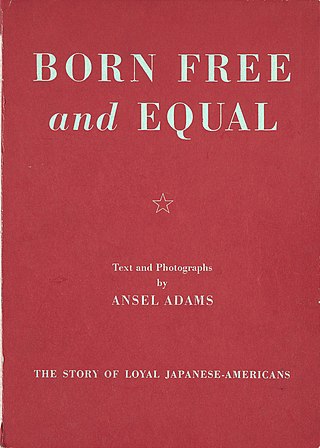
Born Free and Equal: The Story of Loyal Japanese-Americans is a book by Ansel Adams containing photographs from his 1943–1944 visit to the internment camp then named Manzanar War Relocation Center in Owens Valley, Inyo County, California. The book was published in 1944 by U.S. Camera in New York.
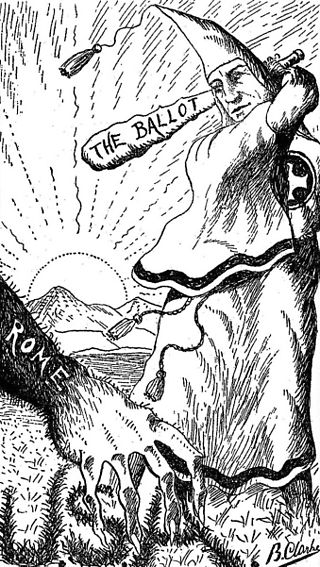
Heroes of the Fiery Cross is a book in praise of the Ku Klux Klan, published in 1928 by Protestant Bishop Alma Bridwell White, in which she "sounds the alarm about imagined threats to Protestant Americans from Catholics and Jews", according to author Peter Knight. In the book she asks rhetorically, "Who are the enemies of the Klan? They are the bootleggers, law-breakers, corrupt politicians, weak-kneed Protestant church members, white slavers, toe-kissers, wafer-worshippers, and every spineless character who takes the path of least resistance." She also argues that Catholics are removing the Bible from public schools. Another topic is her anti-Catholic stance towards the United States presidential election of 1928, in which Catholic Al Smith was running for president.

The Indiana Klan was a branch of the Ku Klux Klan, a secret society in the United States that organized in 1915 to promote ideas of racial superiority and affect public affairs on issues of Prohibition, education, political corruption, and morality. It was strongly white supremacist against African Americans, Chinese Americans, and also Catholics and Jews, whose faiths were commonly associated with Irish, Italian, Balkan, and Slavic immigrants and their descendants. In Indiana, the Klan did not tend to practice overt violence but used intimidation in certain cases, whereas nationally the organization practiced illegal acts against minority ethnic and religious groups.

The Good Citizen was a sixteen-page monthly political periodical edited by Bishop Alma White and illustrated by Reverend Branford Clarke. The Good Citizen was published from 1913 until 1933 by the Pillar of Fire Church at their headquarters in Zarephath, New Jersey in the United States. White used the publication to expose "political Romanism in its efforts to gain the ascendancy in the U.S."
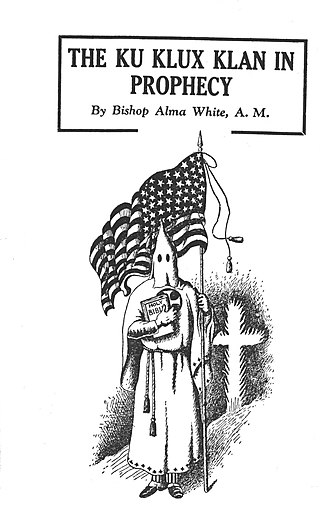
The Ku Klux Klan in Prophecy is a 144-page book written by Bishop Alma Bridwell White in 1925 and illustrated by Reverend Branford Clarke. In the book she uses scripture to rationalize that the Ku Klux Klan is sanctioned by God "through divine illumination and prophetic vision". She also believed that the Apostles and the Good Samaritan were members of the Klan. The book was published by the Pillar of Fire Church, which she founded, at their press in Zarephath, New Jersey. The book sold over 45,000 copies.

Klansmen: Guardians of Liberty was a book published by the Pillar of Fire Church in 1926 by Bishop Alma Bridwell White and illustrated by Branford Clarke. She claims that the Founding Fathers of the United States were members of the Ku Klux Klan, and that Paul Revere made his legendary ride in Klan hood and robes. She said: "Jews are everywhere a separate and distinct people, living apart from the great Gentile masses ... they are not home builders or tillers of the soil." Her book, which contains many anti-Catholic themes, became popular during the United States presidential election of 1928 when Al Smith was the first Catholic presidential candidate from a major party.
Linda Kaufman Kerber is an American feminist, a political and intellectual historian, and educator who specializes in the history and development of the democratic mind in America, and the history of women in America.
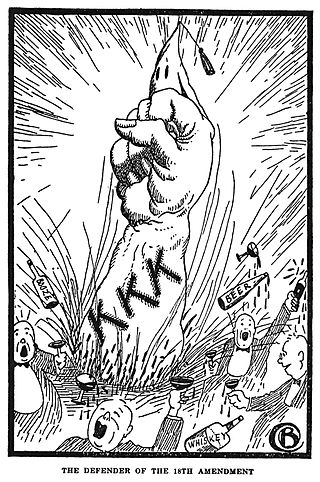
The Ku Klux Klan has had a history in the U.S. state of New Jersey since the early part of the 1920s. The Klan was active in the areas of Trenton and Camden and it also had a presence in several of the state's northern counties in the 1920s. It had the most members in Monmouth County, and operated a resort in Wall Township.
Ku Klux Klan recruitment of members is the responsibility of 'Kleagles', as defined by "Ku Klux Klan: An Encyclopedia". They are organizers or recruiters, "appointed by an imperial wizard or his imperial representative to 'sex' the KKK among non-members". These members were paid 200 dollars per hour by the commission and received a portion of each new member's invitation fee. Recruitment of new KKK members entailed framing economic, political, and social structural changes in favour of and in line with KKK goals. These goals promoted "100 per cent Americanism" and benefits for white native-born Protestants. Informal ways Klansmen recruited members included "with eligible co-workers and personal friends and try to enlist them". Protestant teachers were also targeted for Klan membership.
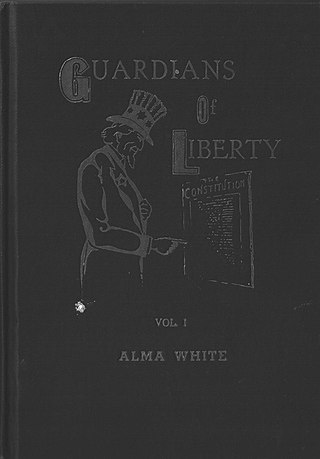
Guardians of Liberty is a three volume set of books published in 1943 by Bishop Alma Bridwell White, author of over 35 books and founder of the Pillar of Fire Church. Guardians of Liberty is primarily devoted to summarizing White's vehement anti-Catholicism under the guise of patriotism. White also defends her historical support of and association with the Ku Klux Klan while significantly but not completely distancing herself from the Klan. Each of the three volumes corresponds to one of the three books White published in the 1920s promoting the Ku Klux Klan and her political views which in addition to anti-Catholicism also included nativism, anti-Semitism and white supremacy. In Guardians of Liberty, White removed most, but not all of the direct references to the Klan that had existed in her three 1920s books, both in the text and in the illustrations. In Volumes I and II, she removed most of the nativist, anti-Semitic and white supremacist ideology that had appeared in her predecessor books. However, in Guardians Volume III, she did retain edited versions of chapters promoting nativism, anti-Semitism and white supremacy.
Rosalyn Baxandall was an American historian of women's activism and feminist activist.

Jane Minor, also known as Gensey Snow, was an African-American healer and slave emancipator, one of the few documented enslaved healing practitioners in United States history.

Nancy K. MacLean is an American historian. She is the William H. Chafe Professor of History and Public Policy at Duke University. MacLean's research focuses on race, gender, labor history and social movements in 20th-century U.S. history, with particular attention to the U.S. South.

Minnie C. T. Love was an American physician and politician from Denver, Colorado. She was an active suffragist, a member of the Colorado House of Representatives, and a member of the Women of the Ku Klux Klan.













